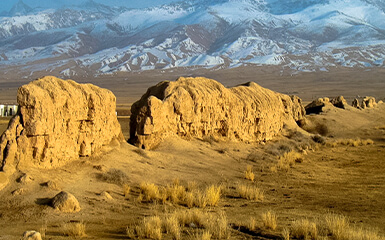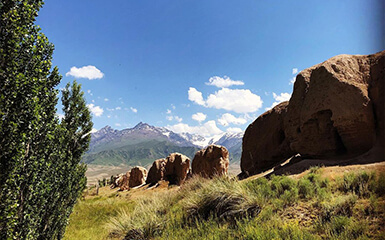Koshoy-Korgon is a remnant of the ancient city of Atbash. It is located on the left bank of the Kara-Koyun River in the At-Bashy district of the Naryn region of Kyrgyzstan, on the outskirts of the village of Kara-Suu.
Koshoi-Korgon is located in the center of the At-Bashy valley. Depending on the conditions of the land, it was strategically located and in ancient times controlled the trade route with this land and the whole valley.
The city has a rectangular shape from 245-250 m. The height of the preserved walls is 4-8 m.
There are 60 castles along their perimeter: 19 in the north, 13 in the south, 17 in the east and 11 in the west. The walls and castles are made of large earthen blocks and long bricks. The wall is 7-9 m thick at the bottom, and 3-4 m thick at the top, which is 8 m thinner. In some parts of the walls and castles, there are traces of subsequent repairs and the remains of thick wood.
They must have been used as building materials. The monumentality of the fortifications protected the people of the city in times of war. On all sides of the city, at a distance of 12 m, there are pits, the walls of which were built after the removal of soil. There were one or four gates on each side of the citadel. Initially, it was supposed to be an only gate to the city
Later, doors opened on the rest of the walls. The eastern and western gates were built in 1375. Amir believes that it appeared when Timur came to the city. In his view, at the same time, an additional wall that occupied a number of areas to the east and south fortified the city. Unfortunately, due to agricultural work, these walls have been completely destroyed in our days.
During excavations of the city, the remains of buildings were found, the walls of which were made of brick, and the floor was paved with earth and flat stones. There are traces of the hearth inside the cow. There are traces of blue, red, white and yellow paint on the plaster of the ceiling of a room.
Various materials were found in the rooms: grinders, clay, stone, bone carvings, some of which were carved. Among the metal objects, the tips of the bow and the fragments of the knife are preserved. Flat bronze objects nailed to belts or yokes are also important. Such decorations are 6-10 cc. Widespread in Turkic-speaking nomadic tribes. Of particular interest is the large bronze ring. It has a picture of two ducks staring at each other. This is the first such discovery in Kyrgyzstan.


